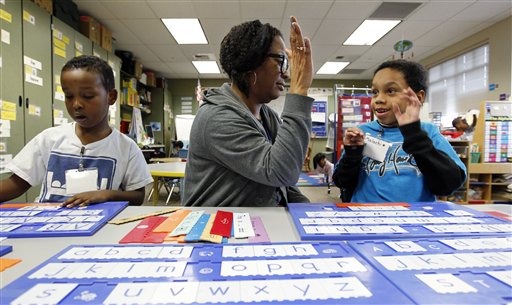
PHILIP ELLIOTT
Associated Press
WASHINGTON (AP) — Education Secretary Arne Duncan is talking with school districts about how to free them from unworkable parts of the federal No Child Left Behind law, signaling he is open to an approach he long tried to avoid.
The Education Department has given 34 states and the District of Columbia permission to ignore parts of the Bush-era No Child Left Behind Law and eight others have waiver applications pending ahead of next week’s application deadline. But that still leaves eight states — giants California and Texas among them — operating under the law and set to fall short of its requirements, such as all students being proficient in math and reading by 2014.
The next step could be allowing school districts themselves to petition for exemptions from national requirements that states are all but certain to fail to meet.
“I’m not saying we are going to go down that path,” Duncan said Thursday before trailing off, “but if we go down that path …”
It seems as though his department is already setting that in motion, however.
California, for instance, failed its first attempt at a waiver and remains a top worry for the Education Department officials.
District superintendents met with federal officials on Wednesday in Washington to talk through options and Duncan joined them for 30 minutes of face-to-face discussion.
“California could reapply. There’s some innings to be played here,” Duncan said, holding out hope just a day after he met with the California Office to Reform Education, or CORE.
That 10-district group includes Los Angeles, San Francisco and Sacramento districts and represents 1.2 million of the state’s 6 million students. It is not representing the statewide California Department of Education.
“My strong preference is to work with states,” Duncan said. “We can manage a portfolio of 50 states. Managing a portfolio of 50,000 districts is lot more difficult.”
But Duncan seems slowly to be softening his opposition to that localized approach to give schools greater control over how to close achievement gaps and lift low-performing schools.
“We’ve given states until the 28th (of February). That’s another week to apply. We’re still waiting to see what states come in,” Duncan said. “Once we get past that deadline, if we’ve had certain places not apply and not show interest, then I think it is incumbent on our team to think through what we do to take that next step.”
Duncan has repeatedly said that he doesn’t want his department to get into district-by-district decisions. Such a shift to approving local projects would potentially add huge workloads to the department and perhaps consume thousands of hours of local districts’ time to assemble the detailed alternatives to improve schools on their own terms.
But the window on that is closing.
The next largest state in student population, Texas, has not even applied for the waivers to No Child Left Behind.
Officials there instead were preparing a broader petition to be exempted from all Education Department mandates, which would include No Child Left Behind. Texas Education Agency spokeswoman Debbie Graves Ratcliffe said the state should have its petition finalized “within the next month or so” but wasn’t pursuing the waivers within the Feb. 28 deadline.
Duncan acknowledges the problems in the No Child Left Behind requirements, first passed into law in 2001 with bipartisan support. In meetings with individual lawmakers and in testimony over the last few weeks, he urged Congress to take up the measure and make adjustments to expectations that no longer are realistic.
If Congress were to update No Child Left Behind, the states would shift to the new national standards — potentially a headache for states that already have set forth on their own individualized plans.
The law expired in 2007 and its requirements have not been updated.
Sen. Lamar Alexander, a Tennessee Republican and former education secretary, said earlier this month that it was Congress’ fault.
“The bottom line is that it expired in 2007 — except for a provision that says if Congress didn’t act, it would continue,” Alexander said during a hearing of the Senate Health, Education, Labor and Pensions Committee where he is the top Republican.
“And Congress didn’t act, so it’s continuing,” he added.



